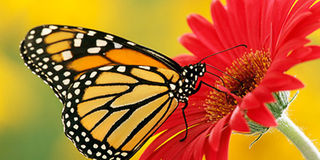Attract birds, butterflies to your compound

Trumpet flowers are visited by butterflies for nectar.
Most home owners who are nature lovers will often beautify their compounds with different kinds of plants as they make them feel close to nature. But do you know which pests the plants attract?
Kristelle Nakimuli, a horticulturist in Kampala, says sometimes nature lovers consult her on how they can improve their compounds to bring in more birds and butterflies.
“Some of these people have lived abroad and have witnessed what they need to transform their home compounds. They seek ideas and suggestions which can help to improve the diversity in their compound gardens. Often, I let them know that a mix of indigenous plants, (trees, shrubs and perennials) or plants, which provide food and shelter, will attract birds and butterflies to their compounds ,” Nakimuli says. “Native plants are easy to care for and are beautiful. They give you time to relax and attract birds and butterflies. They do not need artificial fertilisers or pesticides.
Nakimuli explains that indigenous plants are important as we are not only increasing the biodiversity within the flower garden but the compound owner also feels relaxed seeing all the striking creatures close at hand.
“…attracting butterflies also involves growing plants that blossom with colour and incorporating plants that serve the needs of all life stages of the butterfly. The insects need places to lay eggs, food plants for their larvae (caterpillars), places to form chrysalides and nectar sources for adults. While for birds they prefer a landscape rich in trees and shrubs,” she says.
She adds that much as these creatures may gain from these plants, the home owner benefits from pollination of his/her fruits.
Plants that attract birds
Plants that attract birds and butterflies include; Purple cone flowers. They are a tried-and-true compound staple. Drawn to them and their beautiful blooms attract butterflies and other pollinators. Cone flowers grow well in most places.
Others are cardinal flowers with bright red petals and resemble the flowing robes worn by Roman Catholic cardinals, after which it was named. Birds love them: While few insects can navigate the long tubular flowers, hummingbirds feast on the cardinal flower’s nectar with their elongated beaks. This moisture-loving plant is native across large portions of the country.
Uganda is also blessed with the buddleia (The butterfly bush), perhaps the easiest to grow.
Different varieties will flower in pink, red, purple, and white and usually bloom during the hot seasons. These shrubs need pruning well as they can grow 5’ to 8’ inches from the ground in a single season.
Lavender flowers are mostly purple in colour and grow on spikes. They thrive in a sunny, sheltered position in well-drained soil.
Also, the marjoram (Oregano) a perennial herb, is another flower to grow. It grows from 20 to 80 centimetres tall. It has white, pink or purple flowers they also grow on spikes.
Sunflowers may signify loyalty and longevity for people, but means food for many birds.
Milkweed best known for hosting butterfly caterpillars, attract insects that are great for birds, too. They use the fiber from the milkweed to spin nests for their chicks. They also use the furry part of the seed to line their nests.
Hibiscus would be an impressive addition to any garden but attract both butterflies and birds to your compound.
We also have Lantana Camara a rugged evergreen shrub from the tropics. that attract butterflies. They grow to 6 ft (1.8 m) high and may spread to 8 ft (2.4 m).
This plant is easy to grow and adapt to most soil types. It attracts butterflies when it blossoms and its ripe berries are loved by birds. Too much water and fertiliser reduces its bloom.




